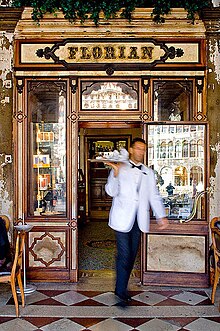Caffe Florian
 |
|
| Private | |
| Founded | 1720 |
| Headquarters | Piazza San Marco, Venice |
| Website | www |
Caffè Florian is a coffee house situated in the Procuratie Nuove of Piazza San Marco, Venice. It was established in 1720, and is the oldest coffee house in continuous operation (with Café Procope in Paris).
The Florian opened with two simply furnished rooms on 29 December 1720 as "Alla Venezia Trionfante" (Venice the Triumphant), but soon became known as Caffè Florian, after its original owner Floriano Francesconi. The Caffè was patronised in its early days by notable people including the playwright Carlo Goldoni, Goethe and Casanova, who was no doubt attracted by the fact that Caffè Florian was the only coffee house that allowed women. Later Lord Byron, Marcel Proust, and Charles Dickens were frequent visitors. It was one of the few places where Gasparo Gozzi's early newspaper Gazzetta Veneta could be bought in the mid-18th century, and became a meeting place for people from different social classes. In 1750 the Florian expanded to four rooms.
In 1773 Valentino Francesconi, the grandson of Floriano Francesconi, took over the business at the beginning of the 19th century. In 1796, in a European atmosphere characterized by the French Revolution, the Venetian State feared that the revolutionary ideas could spread also in Venice. The Florian, with its international clientele, had become a meeting place for many French Jacobins, so the State Inquisitors obliged Valentino Francesconi to close the café. When the French armies entered in Venice, in May 1797, Valentino Francesconi put down the double-obsolete "Venice Triumphant" sign outside the café and replaced it with one simply bearing the name of his uncle "Florian".
In 1814 the Valentino Francesconi passed the café on to his son Antonio.
By 1858 the establishment had passed into the hands of Vincenzo Porta, Giovanni Pardelli, and Pietro Baccanello, and was in need of some restoration. Lodovico Cadorin was commissioned to carry out restoration work and redecorate the interiors. The new rooms were named "Sala del Senato" (Senate Room), "Sala Greca" (Greek Room), "Sala Cinese" (Chinese room) and "Sala Orientale" (Oriental Room).
...
Wikipedia
